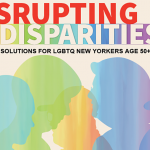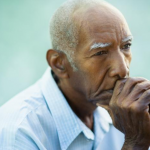For nearly a year, we have lived in the shadow of COVID-19, changing our daily habits to keep ourselves, partners, spouses, colleagues and loved ones safe. Annual holidays became small, intimate affairs, often just including our families of choice. It’s been particularly challenging for LGBTQ+ seniors many of whom identify as disenfranchised. Fortunately, organizations and volunteers across the country are advocating for their care, recognizing that our triumphs have been built on the shoulders of those who came before us.
“It was very revealing that many of our folks were already struggling with isolation but also that many of our participants were used to this,” says SAGE Chief Program Officer David Vincent. “Prior to the shutdown, people were able to come to our centers. While that was inhibited by weather, mobility, or health, they still were able to make it sometimes. But with COVID-19, they were completely isolated from services.”
Founded in 1978, the nonprofit has locations in Harlem, midtown Manhattan, Brooklyn and the Bronx and affiliates throughout the country.
In March 2020, SAGE’s advocacy efforts were instrumental in getting specific wording regarding LGBTQ+ elders into the Older Americans Act reauthorization — the first bipartisan piece of LGBTQ+-inclusive legislation that was passed into law by the Trump administration. The OAA has supported older Americans through programs designed to prevent abuse and neglect, support caregivers, offer employment and community service opportunities, promote nutrition and improve transportation options. But nothing could prepare social service agencies coronavirus’s devastating and far-reaching impact.
At the pandemic’s onset, elders were requesting stabilized access to food and medication — what Vincent calls “the lifesaving pieces.”
“Then it switched to mental health,” says Vincent. “That’s when we started our online programming. In March, we started with 10 different programs during the week. More recently, we’ve had well over 100 different programs each and every week. It’s amazing that we have been able to provide this programming to help meet their social and intellectual needs.”
To bridge the gap between tech-savvy seniors and those who are not, SAGE began to educate interested members on accessing virtual experiences. This has been perhaps the one positive thing to come out of the pandemic: LGBTQ+ seniors are more socially connected than ever before with forums related to health and aging, or just gathering virtually to watch an episode of “RuPaul’s Drag Race” or the recent presidential inauguration.
“Those who don’t use technology can call in from their landline,” Vincent explains. “There is also a program called SAGEConnect in which a volunteer calls a member just to check in. Not just see if they need anything but just have a chat. It makes a difference to have that social connection.”
An Activist Remains Active
Martha Shelley, a Portland-based writer, activist, New York native and veteran of the Gay Liberation Front, has been weathering the pandemic with her wife but recognizes the toll it has taken on her peers.
“I have heard a lot about isolation and seniors,” says Shelley. “People living alone have it really hard. If I did live alone, it would be very hard on me emotionally.”
Shelley and her wife live in the charming Saint John’s neighborhood of the LGBTQ+-inclusive “City of Roses.” Before the shutdown, they were very active with neighbors and local residents. She misses porch chats during nice weather, having people over for dinner parties, and walking their dog with another lesbian couple that lives on the same street. She also is part of a writing group composed of women writers, some of who are lesbian. The group now meets on Zoom, and it has thus far been successful.
“I spend a lot of time talking to friends on the phone,” says Shelley, who also joined a Zoom celebration for one of her longtime activist friends. “We had a birthday party for Esther Newton, an old friend from Gay Liberation days in New York City. And she was 80 this year — we had a birthday party on Zoom — all of her lesbian and non-lesbian friends joined in to celebrate. It was with people from all over the country and some from overseas.”
Views From the Ground
Philadelphia, a city that had a gay rights demonstration one year earlier than the Stonewall Riots, has a vibrant gay community. Since 2014, the Jonathan C. Anderson Apartments (JCAA) has provided apartments for LQBTQ seniors living with a lower or fixed income. The Center City location is in the heart of the famed “Gayborhood.” Just down the block is the William Way LGBTQ+ Community Center (WWCC).
WWCC’s senior program manager Ed Miller says the biggest issue right now among seniors at the Center and the apartment complex is getting vaccinated.
Reports continue to emerge of Pennsylvania’s “confusing” vaccine rollout, made even more difficult for some seniors who may not have regular digital access to the most current updates or resources. There is also generational stigma and mistrust to overcome.
“Due to the tragically weak federal response to the pandemic and the lack of a national strategy, trust in the COVID vaccines is a problem for the country. Only 63 percent of Americans currently indicate a willingness to get immunized against the virus,” wrote SAGE CEO Michael Adams and president and CEO of the National Hispanic Council on Aging, Yanira Cruz, in an op-ed for The Advocate. “This trust deficit is even greater among LGBTQ+ and BIPOC older adults, with non-white adults being among those least willing to be vaccinated. This should come as no surprise. Experiencing discrimination and stigma throughout one’s life leads to high levels of mistrust in the medical profession and government among LGBTQ+ and other diverse elders.”
Despite these challenges and little control over the vaccination rollout, WWCC has been working hard to connect seniors with science-based information and other vital resources.
“There are two programs that have been equally effective, the WWCC MorningOut program and at JCAA the Food and Nutrition program. MorningsOut is the senior men’s social group that remarkably only missed one week in March moving from in person at the Center to our virtual zoom option due to the pandemic. The group meets every week with travelogues, invited guest speakers, group discussion topics and general check-ins to see how people are faring.”
“The Food and Nutrition program at JCAA has [also] been a lifeline for many of the residents who used our food shopping van service before the pandemic. The community has been terrific supplying masks, gloves, hand sanitizer and food. And through a grant for food and nutrition, WWCC is now providing bi-weekly delivery of groceries to the residents.”
Only a fraction of JCAA residents goes “out and about.” Still, they find safe ways to stay connected with their neighbors, whether it’s socially distanced get-togethers in the garden (the outdoor deck has been closed since March) or going for neighborhood walks. Inside the building, there has been an even further sense of community. Residents put chairs in the hallway and have socially-distanced coffee clutches with fellow residents.
“Just like the older ladies used to do in South Philly,” says Miller, referencing Philadelphia’s historic Italian-American community. “Just no lawn chairs.”
In Cleveland, Ohio, Mary Beth Bartholomew serves as the SAGE coordinator at , which serves approximately 300 members throughout the region.
“Currently, we are not offering in-person programs,” says Bartholomew. “We offer Zoom programming for yoga, tai chi, tabletop conversations, guided meditation and a weekly mental health support group. Our older adults greatly miss coming to The Center. This generation of elders fought for our rights, but many have not benefited from cultural and legal shifts. There is great suspicion of institutions because of past perceived or real discrimination and violence. Coming to The Center is one of the few places, or only place, where folks can congregate where they feel safe in an affirming environment.”
Bartholemew confirms the disparity regarding elders and technology. Before the second shutdown, the Center purchased tablets for a small number of SAGE participants. Though they have what she calls “meaningful Zoom programming,” the majority of participants don’t log on for various reasons such as a lack of technological skills, fear of the technology, or simply a general disinterest. But members have found other ways to beat the lockdown blues.
“A cohort of SAGE participants meet weekly, in Cleveland weather, for walks. This is something that has developed organically and illustrates that real bonds have been made,” says Bartholemew. “Participants are very eager for the vaccine hoping that some form of normalcy will return. And for them, that means being able to return to The Center… while some people are a bit depressed and frustrated, this group is very resilient. They’ve led long, sometimes hard lives, survived the AIDS crisis and have realistic expectations.”
Resilience emerges as a common theme — from Shelley’s perspective as an early LGBTQ+ advocate during the Gay Liberation Front, to Bartholomew’s recognition of a generation of queer elders who fought and won against social injustices, to Miller’s observation that those he serves wish to see the pandemic end and things get back to normal.
“During this really challenging time, we have seen innovation and an amazing sense of resilience,” echoes Vincent from his home-office in Manhattan. “This doesn’t just include SAGE — the whole industry of service providers to help meet elder or senior needs. As LGBTQ+ folks, we are inspired by their resilience through discrimination, marriage inequality, underemployment, and the AIDS crisis. Our seniors continue to be resilient, and we will be better because of it.”
This article was originally published in Edge Media Network on January 29, 2021.







